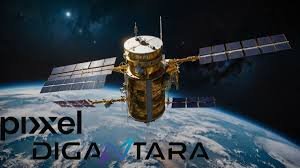Pixxel and Digantara Launch Satellites for Earth and Space Monitoring
Introduction
In a significant leap for space technology, Pixxel, a prominent Indian space tech startup, in collaboration with Digantara, a space data company, launched two advanced satellites for earth and space monitoring. The launch, which took place in January 2025, marks a crucial step toward the growing space capabilities of India and its role in monitoring global changes related to both Earth and outer space.
Overview of the Launch
The partnership between Pixxel and Digantara aims to provide data on earth’s environment, focusing on climate change, natural disasters, and agriculture. Pixxel’s Earth Observation Satellite (EOS-1) is equipped with cutting-edge imaging technology, while Digantara’s Space Monitoring Satellite (SMS) will provide crucial data for tracking space debris and satellite health. Both satellites are part of a broader mission to offer real-time data to help countries manage space debris, monitor the environment, and improve disaster response systems.
Technological Advancements and Applications
The technological innovation presented by these satellites promises groundbreaking advancements in Earth and space monitoring. Pixxel’s satellite uses high-resolution imaging technology, which can provide detailed pictures of natural resources, urban sprawl, and deforestation. Digantara’s space monitoring satellite, on the other hand, is designed to help in tracking space debris, offering solutions for collision avoidance and improving satellite health management.
This dual satellite initiative is pivotal in promoting sustainability, enhancing space security, and helping policymakers make informed decisions related to environmental and space policy.

Why this News is Important
Significance for India’s Space Program
The launch of these satellites signifies a substantial milestone for India’s space industry. India is rapidly advancing in space technology, and with the contribution of private players like Pixxel and Digantara, the country is gaining significant ground in the global space race. This move demonstrates India’s growing capabilities in space innovation and its ability to provide solutions for global challenges, particularly those related to climate change, natural disasters, and space debris management.
Impact on Environmental and Space Research
These satellites will play a crucial role in monitoring environmental changes such as deforestation, global warming, and the effects of natural disasters. The data collected by Pixxel’s EOS-1 will offer critical insights that can help countries prepare for and mitigate the impact of climate-related crises. Moreover, Digantara’s SMS will address the growing concern of space debris, a serious threat to the sustainability of satellite systems and the safety of astronauts in space.
For students preparing for government exams in the space, environmental, or technological sectors, this news underscores the importance of collaboration in space technology and the growing influence of Indian space startups on global platforms.
Historical Context
India’s Progress in Space Technology
India’s space journey began in 1969 with the establishment of the Indian Space Research Organisation (ISRO). Over the decades, India has achieved major space milestones, including the successful launch of satellites, missions to the Moon and Mars, and the development of a robust space infrastructure. The launch of India’s first satellite, Aryabhata, in 1975 was a stepping stone toward India becoming one of the world’s prominent space-faring nations.
In recent years, the rise of private space companies such as Pixxel and Digantara is creating new opportunities for innovation and collaboration in the Indian space sector. The government has also been supportive through initiatives like Atmanirbhar Bharat (self-reliant India), which encourages private players to enter the space industry and contribute to India’s global position.
Space Debris and Global Monitoring Efforts
Space debris has been a growing concern since the early days of satellite launches. As of recent reports, there are thousands of non-functional satellites, spent rocket stages, and other pieces of debris that orbit Earth, posing a threat to operational satellites and even the International Space Station (ISS). The creation of space monitoring technologies like Digantara’s SMS is a response to this increasing challenge.
Key Takeaways from “Pixxel and Digantara Launch Satellites for Earth and Space Monitoring”
| # | Key Takeaway |
|---|---|
| 1 | Collaboration between Pixxel and Digantara: The two companies launched satellites to monitor both Earth’s environment and space. |
| 2 | Pixxel’s EOS-1 satellite: Equipped with advanced imaging technology to monitor Earth’s natural resources and climate changes. |
| 3 | Digantara’s SMS satellite: Designed to monitor space debris and ensure satellite health, contributing to space security. |
| 4 | Significance for India’s space sector: The launch marks a major milestone in India’s growing space industry and private sector involvement. |
| 5 | Global impact on sustainability: The data from these satellites will assist countries in climate change mitigation and disaster response planning. |
Important FAQs for Students from this News
What are the names of the satellites launched by Pixxel and Digantara?
The two satellites launched are Pixxel’s EOS-1 (Earth Observation Satellite) and Digantara’s SMS (Space Monitoring Satellite).
What is the main purpose of the Pixxel EOS-1 satellite?
The primary purpose of the EOS-1 satellite is to provide high-resolution imaging for monitoring Earth’s environment, including climate change, natural disasters, and agricultural trends.
What role does the Digantara SMS satellite play?
The SMS satellite by Digantara is designed to monitor space debris and track satellite health, ensuring the safety of operational satellites and reducing the risks of collisions in space.
Why is the collaboration between Pixxel and Digantara significant?
This collaboration represents a major milestone for India’s private space industry, combining efforts in both Earth monitoring and space security, further positioning India as a leader in space technology.
What are the potential benefits of these satellites for global environmental monitoring?
The Pixxel EOS-1 satellite will aid in disaster response, agriculture monitoring, and environmental protection, offering critical data for addressing climate change and global resource management.
How does the launch of these satellites impact India’s space sector?
This launch highlights India’s growing capabilities in space, showcasing the increasing involvement of private space companies like Pixxel and Digantara, and strengthening the nation’s position in global space exploration and technology.
Some Important Current Affairs Links


















